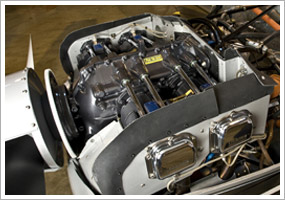| The following stories from the January 16, 2009, edition of AOPA ePilot were provided to AOPA members who expressed an interest in the particular subject areas. Any AOPA member can receive information tailored to their areas of interest by updating their preferences online. TRAINING TIPsNormally aspirated engines
You are training in a 1986 Cessna 172P, so you reply that the engine is a normally aspirated, air-cooled, carburetor-equipped, four-cylinder engine. You also know from studying the pilot’s operating handbook (POH) that this piston engine is rated at 160 horsepower at 2,700 rpm. The examiner is satisfied with your answer, but poses another question: What is the difference between a normally aspirated engine and a turbocharged engine?
You’ve done your homework, and you’re ready with a response. As explained in the article “Turbochargers: Better Performance at Altitude” (that you can read on the AOPA Flight Training Web site), a piston engine “produces its maximum power when it breathes air at sea-level pressure. Because air pressure and density decrease with altitude, an engine becomes increasingly breathless as it climbs. As a result, its power output decreases.” The article adds that “exhaust-driven turbochargers solve this problem because they compress the thin air, restoring its density, before the engine inhales it.”
A related difference, then, is that a normally aspirated aircraft will have a lower service ceiling than a turbocharged version of the same make and model. “Service ceiling” is a term found in your aircraft POH and discussed in the Aug. 5, 2005, “ Training Tip.”
Just because your normally aspirated engine isn’t capable of the same power output at altitude as a turbocharged engine doesn’t mean that you need never be concerned about exceeding rated power limitations. That’s especially true in the cold dense air of winter, when temperatures fall well below standard (see the Jan. 2, 2009, “ Training Tip” on standard temperature). Consider this guidance provided in the FAA publication Tips on Winter Flying, also available at AOPA Online: “Care should be exercised in operating normally aspirated engines. Power output increases at about 1 percent for each 10 degrees of temperature below that of standard air. At -40 degrees F an engine will develop 10 percent more than rated power even though RPM and MP (manifold pressure) limits are not exceeded.”
Hot weather or cold, power management is an art that all pilots must practice. TRAINING PRODUCTSMax Trescott produces ‘Learn to Fly’ ebook Max Trescott, 2008 CFI of the Year, has created an electronic book that you can send to friends who are interested in learning to fly. The 37-page .pdf file looks at case studies of three individuals who learned to fly for different reasons: for pleasure, as a business tool, and as a career. The book can be downloaded free from the Web site. Note: Products listed have not been evaluated by ePilot editors unless otherwise noted. AOPA assumes no responsibility for products or services listed or for claims or actions by manufacturers or vendors. FINAL EXAMQuestion: If I do all of my private pilot training in a tailwheel aircraft, do I still need the tailwheel endorsement before I can solo in a tailwheel airplane?
Answer: A student pilot needs a lot of endorsements in order to complete his or her initial solo flight. The required endorsements include the presolo aeronautical knowledge, presolo flight training, and the actual solo endorsement. And yes, if you plan to complete your solo in a tailwheel airplane, you will also need a tailwheel endorsement. For some additional insight, see this Flight Training magazine article on the pros and cons of training in a taildragger.
Got a question for our technical services staff? E-mail to [email protected] or call the Pilot Information Center, 800/872-2672. Don't forget the online archive of "Final Exam" questions and answers, searchable by keyword or topic. |
 “Tell me some facts about your aircraft’s engine,” says the designated pilot examiner as you prepare to fly for your private pilot practical test.
“Tell me some facts about your aircraft’s engine,” says the designated pilot examiner as you prepare to fly for your private pilot practical test.

